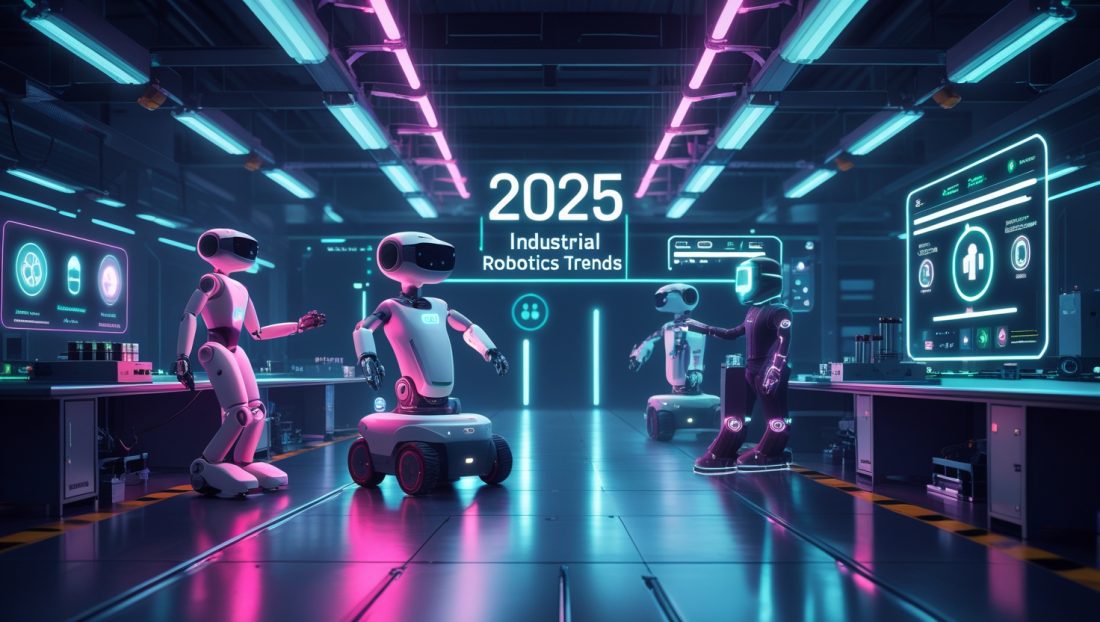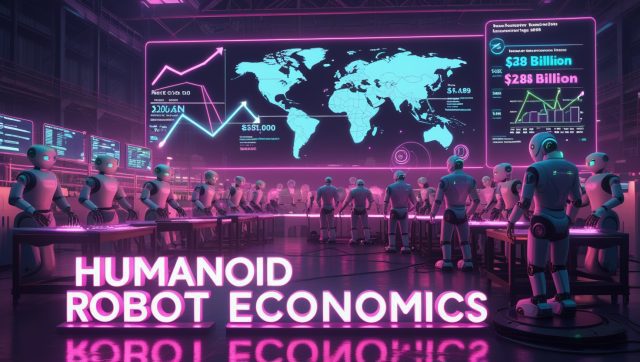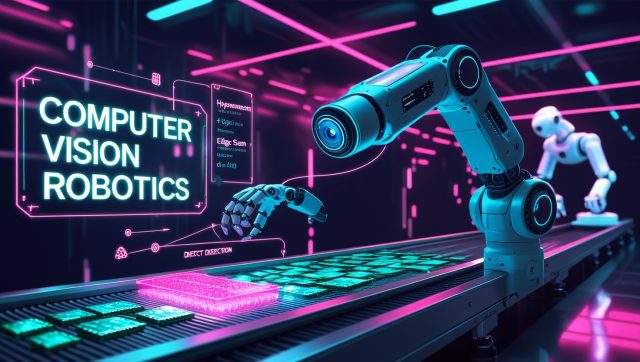The Silent Revolution on the Factory Floor
Walk through any modern factory, and you’ll notice it: fewer clanging metal presses, fewer workers straining over conveyor belts. Instead, autonomous mobile robots glide between workstations, collaborative arms assist technicians with micron-level precision, and AI systems predict maintenance needs before a single sensor fails. This quiet transformation, driven by industrial robotics trends, represents more than incremental change—it’s a fundamental restructuring of global production fueled by intersecting crises.
A record 75% of manufacturers face severe labor shortages, while sustainability mandates and supply chain fragility force operational reinvention. Industrial robotics has shifted from a luxury to a survival toolkit, projected to explode from $55.1 billion in 2025 to $291.1 billion by 2035.
“We’re creating coworkers, not replacements,” states Melonee Wise of Agility Robotics. “Robots handle backbreaking logistics so humans focus on complex problem-solving.”
Why This Transformation Can’t Wait
- Labor Demographics Collide: Japan’s workforce shrinks by 500,000 annually; the U.S. faces 2.1 million unfilled manufacturing jobs by 2030.
- Sustainability Deadlines Loom: UN Sustainable Development Goals require 45% emissions cuts by 2030, pushing robots into climate-warrior roles.
- AI Maturity Meets Urgency: Physical AI now simulates real-world physics, letting robots “practice” complex tasks millions of times digitally before execution.
1. Industrial AI: The Cognitive Leap Beyond Automation
Industrial AI transforms robots from blind executors into adaptive decision-makers. Unlike legacy systems requiring rigid coding, modern platforms leverage:
Physical AI: Simulation-Born Intelligence
NVIDIA’s Isaac GR00T N1.5 exemplifies this shift. Robots train in hyper-realistic virtual environments, learning through simulated experience rather than manual programming. This enables autonomous skill acquisition—like mastering variable welding paths through digital rehearsal. At Munich’s Automatica 2025, NVIDIA demonstrated robots trained via Isaac Sim that adapted grip techniques for irregular aircraft components within minutes.
This leap in robotic simulation training slashes development costs and accelerates deployment. By simulating millions of scenarios, robots achieve up to 95% accuracy in tasks like precision assembly without physical prototypes, per NVIDIA’s 2025 benchmarks. This aligns with innovations like physical AI simulation, which cuts training expenses by 60%, enabling smaller manufacturers to adopt advanced robotics. Forbes highlights how such simulations are redefining scalability, making high-cost errors obsolete.
Analytical AI: Data as the New Sensor
Vision systems now analyze historical production data to detect microscopic defects. An automotive supplier slashed defect rates 34% using AI that identified micro-cracks invisible to human inspectors. BMW’s partnership with Google leverages BigQuery and Vertex AI to analyze billions of data points daily from 4.6 million vehicles, enabling real-time fleet optimization.
Generative AI: The Language of Machines
Natural language commands replace weeks of reprogramming. Tell a robot, “Reposition that weld seam by 2mm,” and it recalibrates instantly. Mercedes-Benz integrates conversational AI into vehicle assembly lines, where technicians verbally instruct cobots during customizations.
This natural language robotic control empowers workers with minimal coding expertise to manage complex systems, boosting adoption in SMEs. Mercedes reported a 25% reduction in training time for new staff, per a 2025 case study. Technologies like AI audio search further enhance this, enabling voice-driven diagnostics that cut decision-making delays by 30%. TechCrunch notes that such interfaces are critical for scaling automation in diverse workforces.
Real-World Impact: Shell’s AI-driven predictive maintenance processes 20 billion weekly data points across 10,000 equipment units. Result: 40% fewer failures and 35% less downtime.
2. Collaborative Robotics: The Democratization of Automation
Gone are the days of robots caged behind safety fences. Modern collaborative robots blend force-sensing, computer vision, and intuitive interfaces:
No-Code Simplicity
Universal Robots’ AI Accelerator lets workers train cobots via drag-and-drop interfaces. One SME reduced packaging line setup from 8 hours to 45 minutes.
Safety by Design
Laser scanners and torque limits enable shared workspaces. Siemens deploys cobots for delicate circuit board soldering alongside technicians.
Economic Accessibility
Priced 40–60% below traditional robots, cobots empower small-batch producers. A bakery equipment manufacturer credits them for competing against industry giants.
“They let us punch above our weight,” admits a Midwest machine shop owner deploying UR15 cobots for CNC tending.
The affordable collaborative robotics trend is a game-changer for SMEs, with cobots like the UR15 driving a 50% increase in automation adoption among small firms, per 2025 IFR data. McKinsey highlights how modular design strategies and Robotics-as-a-Service (RaaS) models are reshaping capital investment in manufacturing
3. Sustainability: The Unavoidable Automation Imperative
Robots now serve as climate compliance tools. With regulations tying supplier contracts to emissions reporting, automation delivers quantifiable eco-gains:
Energy Recapture
ABB’s regenerative brakes convert deceleration energy into reusable electricity, cutting consumption 30%.
Waste Slashing
AI-guided cutting robots in aerospace optimize titanium nesting, reducing scrap by 22%.
Circular Economy
Fanuc’s e-waste bots sort 200 items/minute, recovering rare earth metals from discarded electronics.
Compliance Catalyst
Automakers now mandate robotic precision for Scope 3 emissions tracking. Suppliers failing compliance risk delisting.
4. Humanoids & New Frontiers: Beyond the Factory Walls
While humanoids dominate headlines, their real value lies in niche applications:
Single-Purpose Humanoids Gain Ground
- Warehousing: Hyundai plans “tens of thousands” of Boston Dynamics’ Digit models for logistics by 2027, handling irregular items that baffle traditional AMRs.
- Construction: Semi-autonomous bricklayers like RoboAds erect walls 3x faster with millimeter precision.
Unexpected Sector Infiltration
- Agriculture: CNH’s apple harvesters operate 24/7, mitigating seasonal labor shortages.
- Retail: Simbe Robotics’ Tally audits shelves nightly, ensuring stock accuracy while freeing staff for customer engagement.
5. Solving the Labor Crisis: Automation as Strategic Lifeline
Demographics dictate inevitability:
Dangerous Task Absorption
Welding bots at Hyundai eliminate respiratory hazards; AMRs move 1-ton pallets injury-free.
Upskilling Catalyst
BMW retrained 45% of assembly staff as robot supervisors, boosting retention and wages.
Reshoring Enabler
Adidas’ “Speed Factories” produce shoes locally at Asian offshore costs through robotic precision.
Regional Analysis: Where the Robotic Revolution Concentrates
| Region | Market Share (2025) | Growth Driver | Key Player |
|---|---|---|---|
| North America | 38% | Reshoring incentives | Boston Dynamics |
| Asia-Pacific | 31% | Electronics/EV demand surge | Fanuc, DJI |
| Europe | 22% | Green manufacturing mandates | KUKA, ABB |
Source: Roland Berger, IFR, GlobeNewswire
East Asia will surge fastest (19% CAGR) through 2035, fueled by China’s semiconductor self-sufficiency push. Europe lags in adoption but leads in sustainable robotics R&D.
Implementation Roadmap: Avoiding the Hype Trap
Deploying robotics requires strategic pragmatism:
- Start Small: Pilot cobots on single processes like machine tending before scaling.
- Build Data Foundations: Integrate IIoT sensors to feed AI algorithms. BMW’s digital twin initiative cut supply chain errors 18%.
- Co-Create with Workers: Involve floor staff in bot selection. Fear turns to ownership when technicians help train cobots.
- Embrace RaaS: Robot-as-a-Service models reduce SME upfront costs by 60%.
- Prioritize Cyber-Resilience: KUKA’s iiQKA.OS2 embeds security protocols against rising ransomware threats.
Beyond 2025: The Next Disruption Wave
- Quantum Leap: DARPA trials suggest quantum computing could accelerate robot path planning 1000x by 2030.
- Agentic AI Ecosystems: Microsoft envisions “constellations of agents” autonomously handling inventory alerts, supplier negotiations, and order execution.
- Generative Design Dominance: Siemens’ AI copilot optimizes turbine components, achieving 75% weight reduction and 30% faster production cycles.
“The gravest error? Viewing robotics as a cost center. It’s a resilience strategy,” notes a Roland Berger automation lead. “Plants blending human ingenuity with machine precision will dominate this decade.”
The Human Imperative
Industrial robotics in 2025 solves impossible equations: boosting productivity amid worker shortages, enabling sustainability without sacrificing margins, granting SMEs the agility of giants. At Toyota’s Texas plant, engineers now oversee AI-optimized assembly lines—roles that didn’t exist three years ago. Their task? Ensuring robots complement human creativity, not replace it. As one technician remarked, “I’m not maintaining machines; I’m teaching them to see.”
Explore Further:
- IFR: Top 5 Robotics Trends 2025
- McKinsey on AI in Industrials
- NVIDIA Robotics Innovations
Your Next Move?
The robotics revolution isn’t coming—it’s here. Manufacturers delaying adoption face irreversible competitive erosion. Subscribe to our Newsletter for monthly implementation spotlights or download our Cobot Integration Checklist to begin your transition (coming soon). The question isn’t whether to automate, but how swiftly you’ll harness this transformation.



